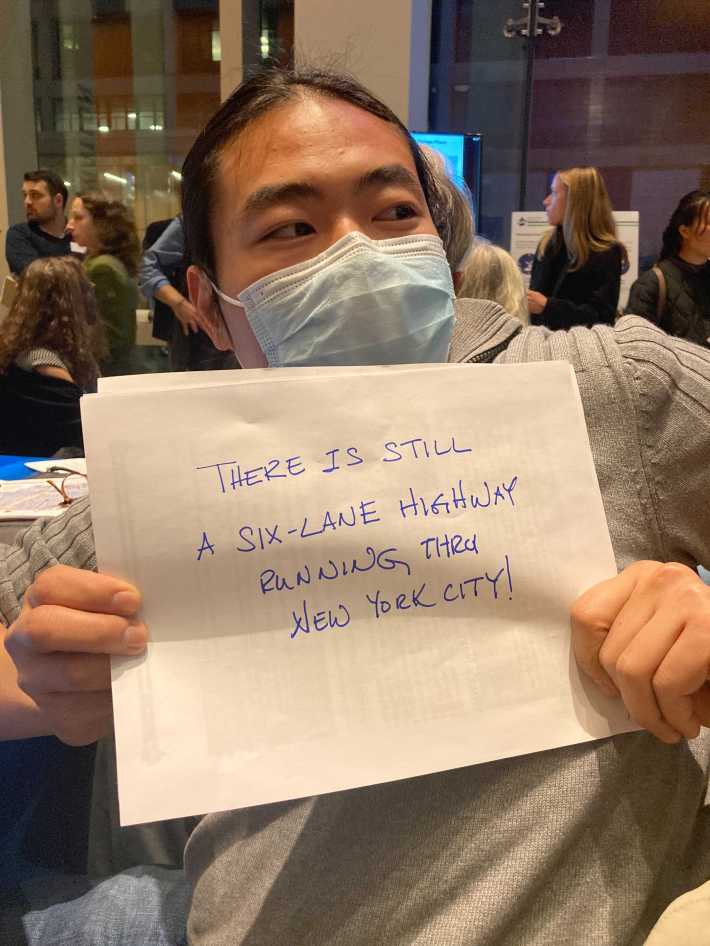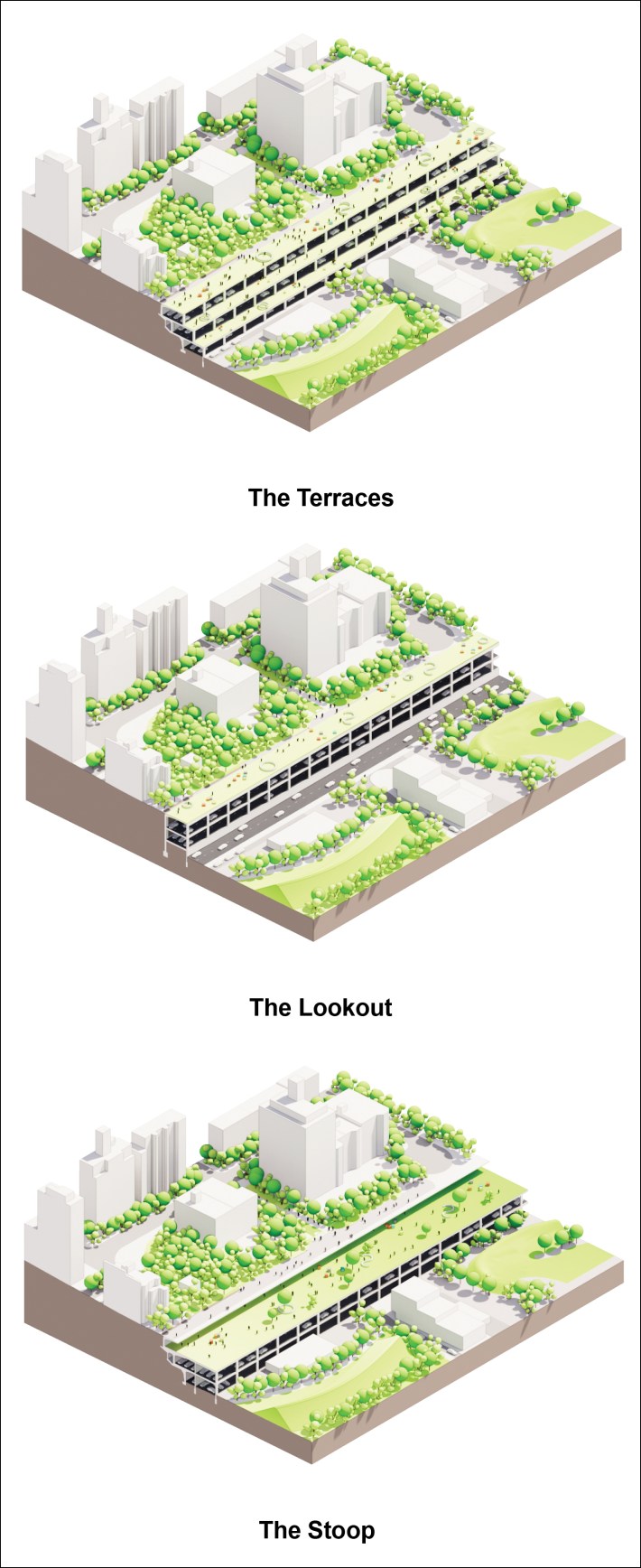Locals Don’t Love the City’s Long-Awaited Re-Widening of Crumbling BQE
12:01 AM EST on December 14, 2022

Before and … after? Graphic: NYC DOT

The city on Tuesday unveiled long-awaited plans for the beleaguered triple-cantilever section of the Brooklyn-Queens Expressway, proposing three fairly similar options for a redesign of the crumbling infrastructure that will restore three lanes of traffic in each direction, albeit with a park on top.
Confirming Streetsblog’s exclusive earlier in the day of the plan to restore the hated highway's six lanes of traffic on the stretch between Atlantic Avenue and Sands Street, Department of Transportation officials revealed that they will likely have to restore a third lane to the current two, and widen the highway, to be in compliance with federal and state regulations. That was upsetting news to locals and advocates who said members of the community had pushed for more imaginative ideas that would maintain infrastructure but also reduce the amount of driving that a wider highway will likely induce.
“It’s really weird that there was a long process with a lot of really creative ideas people had for this highway re-envisioning, we talked about everything from bus rapid transit to affordable housing opportunities,” said Liz Denys, a member of the advocacy group Bridges 4 People. “It's hard to see how this will translate if we’re maintaining the size.”
I don't understand why reducing private car and truck traffic isn't an explicit goal of @NYC_DOT's highway revisioning... and every DOT project for that matter. NYC needs to reduce car and truck dependence to ensure we even have a future in the face of climate change.
— Liz Denys (@lizdenys) December 14, 2022

The three options are all variations of the same concept. Called the Stoop, the Terraces, and the Lookout, each one includes either a full or partial rebuild of the dilapidated retaining wall along Hicks Street to include three lanes with green space built on top in order to conceal the highway and connect to the promenade above and Brooklyn Bridge Park down below.
City officials said during a technical briefing ahead of the public workshop that DOT was willing to explore two lanes as an option, but that the roadway, which carries nearly 153,000 vehicles a day, would be restored to three. The third lane could be designated as a shoulder, or for High Occupancy Vehicles or electric vehicles, the officials said.
But what the city proposed on Tuesday is not the bold redesign New Yorkers were promised — first by former Mayor de Blasio in 2021 and again by current Mayor Adams this past September — it felt more like a superficial revamp that focused more on appearance rather than crucial issues like congestion and safety, William Meehan said on Twitter after the city’s presentation.
“The (DOT) meeting on the BQE has a lot of focus on beautification and very little on pollution, congestion, or safety. Greenwashing "shoulders" as transit lanes for bus lines that don't exist. It's lipstick on a pig,” Meehan said.
And Amy Breedlove of the Cobble Hill Association found the city’s wavering on basic facts frustrating. Breedlove was at a meeting a few days ago and remains unsure if whether the rebuilt section will be two lanes with a shoulder, or two with an HOV lane, or simply just three lanes.

“Now they’re saying two lanes plus a breakdown lane, that's not what they were saying the other day, so I’d like clarification,” said Breedlove.
Among other unanswered questions was how much it would all cost. Officials could not provide a dollar amount for any of the proposed designs to the city-owned section, saying only that they hope to take home some federal cash for the project this spring.
And it is unclear what Tuesday's design options will mean for remnants of the Robert Moses-era highway along the rest of the corridor from Queens down to the Verrazzano Narrows Bridge — like the trench that slices through several neighborhoods, and the elevated highway structures in Sunset Park and Williamsburg. Work to redesign the 1.5-mile section between Atlantic Avenue and Sand Street, including the 0.4-mile triple cantilever isn’t slated to start for at least five more years. "Short term improvements" on sections on either side of the so-called BQE Central are expected to begin as early as next year, the DOT said.
It remains to be seen whether the less-wealthy neighborhoods on either side of Brooklyn Heights, DUMBO and Cobble Hill will get their scar of a highway covered over and festooned with new public green space.
Brooklyn Council Member Lincoln Restler, who represents sections of the BQE, declined to opine on the design options on the table, but said he’s hopeful for a “better outcome.”
“It sounds like DOT’s decision-making process is fluid and I hope that strong feedback from our community will shape a better outcome as we move forward,” said Restler. “We cannot accept status-quo highway infrastructure across our communities. We have an opportunity here to dramatically reduce the impacts of cars and trucks. I’m hopeful we can get to a project that actually leads to a more environmentally just community than where we are today.”
After initial publication of this story, Brooklyn Borough President Antonio Reynoso issued a statement on the city's designs, similarly expressing concern that they don't go far enough to address the environmental injustices communities all along the corridor have been forced to bear. And he called on legislators up in Albany to come up with a viable solution for the rest of the state-owned highway.
“What was initially presented as a comprehensive approach to re-envisioning the entire BQE corridor has quickly devolved into a process that is focused solely on the city-owned cantilever portion of the expanse. This approach sidelines the environmental justice communities that have been negatively impacted by the BQE for decades," Reynoso said. "It is past time for our partners at the state level to make a real commitment to envisioning and quickly implementing solutions for the state-owned portions of the BQE to the north and south. We have a once-in-a-generation opportunity to get this right, it’s time for us to come together and produce forward-looking solutions that work for all of Brooklyn.”
There will be a follow-up virtual session on Thursday, Dec. 15 at 6:30 p.m. Click here to register in advance.
Julianne Cuba joined Streetsblog in February, 2019, after three years covering local news and politics at The Brooklyn Paper. There, she also covered the notoriously reckless private carting industry and hit-and-runs. A 2015 graduate of Stony Brook University’s School of Journalism Master’s Program, she lives in Brooklyn. Julianne is on Twitter at @julcuba. Email Julianne at julianne@streetsblog.org
Stay in touch
Sign up for our free newsletter
More from Streetsblog New York City
Thursday’s Headlines: Speed-Limiting Tech Edition
State Sen. Andrew Gounardes continues his push to force reckless drivers to install speed limiters in their cars. Plus more news.
DOT Official: All Our Free Parking Justifies Keeping Curb Space for EVs
If only someone could do something about the parking!
New York City to Install 500 Secure Bike Parking Hubs In The Next Five Years: Sources
Your bike may finally get a roof over its head.
Adams Backs Lower Speed Limits, Calls Crashes ‘Accidents’
The mayor wants New York City drivers to "slow down," but it's not clear yet how many streets will get lower speed limits.
Wednesday’s Headlines: Trump Posts About Congestion Pricing Edition
Donald Trump comments on congestion pricing — no surprise, he's against it. Plus more news.




